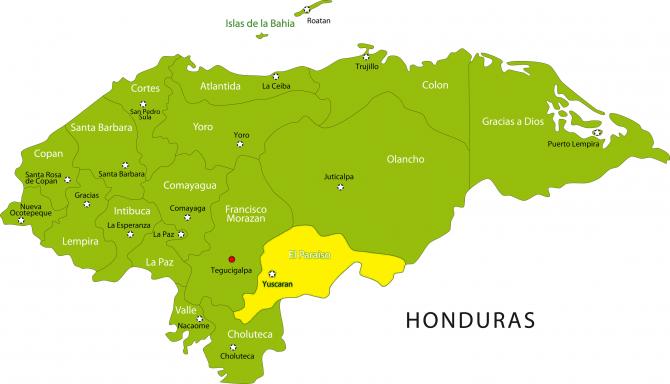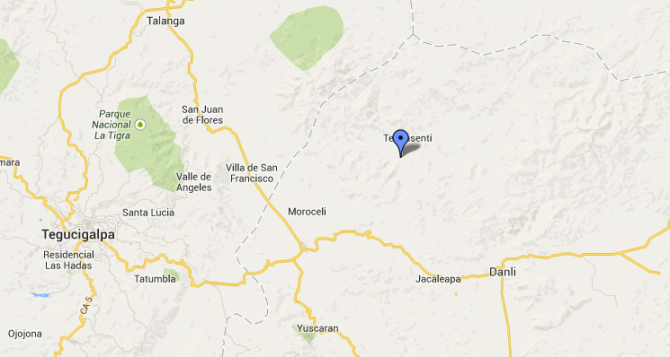Santa Rosa, Honduras
![]()
![]()
![]()
![]()
![]()
![]()
![]()
![]() Click on Programs to learn more about their work in this community
Click on Programs to learn more about their work in this community
General Information
| Population* | 500 |
| Number of homes | 100 |
| Avg # of people per home | 5 |
| Number and % of children | 40: 8% of the population |
| Primary Occupations | Agriculture (corn and beans) |
| Water System | Yes |
| Community Bank | No |
| Electricity | Yes |
| Corresponding Health Center & Distance | CESAMO - Teupasentí |
| Common Illnesses | Chronic illness and hypertension |
| School Access and Distance |
Primary School - In community Secondary School - In community |
| GPS |
N 14° 11.760’ W 086° 43.447’ |
| Municipality | Teupasentí |
| Department | El Paraíso |
| Distance from compounds | 2 hours |
* Population does not reflect how many patients will be seen on medical
brigades as many people from surrounding communities come seeking
Medical Brigades medical attention.
Top Three Needs Expressed
The top three needs expressed by the key community members are a community center, a health center and latrines.


Santa Rosa is located in a valley near the large town of Teupasentí. Due to its altitude, it is hot during the day and cooler at night. It is surrounding by rolling hills with a mix of forest and farmland.
Santa Rosa #1’s educational system includes Kinder and  Primary schools (through 6th grade). There are 90 students at the schools in the community and Maria Luque de Maradiaga is the school director. It is approximated that about 75% of the community knows how to read and write.
Primary schools (through 6th grade). There are 90 students at the schools in the community and Maria Luque de Maradiaga is the school director. It is approximated that about 75% of the community knows how to read and write.
Santa Rosa #1 has a water system that was first constructed in 1985. The main problems with the system is that the tubing is old and needs replaced and there is only 60% of the community connected. Water arrives every day, but it is not being chlorinated once every 2 weeks1. There is a Water Council with 3 active members, led by Miguel Angel Castillo and Maria Maradiaga.
Santa Rosa does not have a rural health center in the community. The nearest health center is in Teupasenti, about a 1-hour walking distance, and is staffed by full-time physicians and nurses including Lic. Doris Lainz. There is a health committee made up of 5 members that mostly monitors child growth and nutrition. Dental care is not available in community, though it is available in Teupasenti.
The most common illnesses seen by community members are asthma, malaria, and diarrhea. Approximately 30% of the community has latrines that currently function. Less than 1% has eco-stoves (estufas justas); the majority use normal stoves with chimneys. About 5% is estimated to have cement floors and 5% to have pilas (water storage units).
The average family income per month is estimated to be 1500 Lempiras, which is approximately L300 (US $15.88) per person3. The majority of homes are made of adobe. The main form of employment is in agriculture on owned land and the main products that are cultivated in the community are corn and beans. Members of Santa Rosa #1 have access to credit from Cooperativa Apaguis and BANADESA, a national agricultural loan agency, in addition to a community bank led by Pedro Rosales.
Santa Rosa is one of several communities in the large Teupasenti region where Global Brigades has a large presence and a strong working relationship with the local mayor.
Santa Rosa does not receive medical brigades from any organization other than Global Brigades. Currently, only Educatodos is working in the community in adult literacy and continued education programs.
Check back soon for pictures of Santa Rosa #1
Source of information: Key informant interview, Centro de Salud statistics
Date of interview: 21 May 2010
1The accepted regulation frequency for chlorinating water is every 4 days.
2CESAMO and CESAR are terms used for types of health centers. CESAMOs are larger, more comprehensive facilities that usually have a physician on staff at all times and occasionally a dentist. CESARs are more remote, less equipped facilities, usually with 1-2 nurses on staff.
3According to Red Solidaria and World Food Programme in Honduras, the average family is approximated at 5 people per household, the poverty line is L930 (US$49.23) per person per month, and the extreme poverty line is L617 (US$32.66) per person per month.
